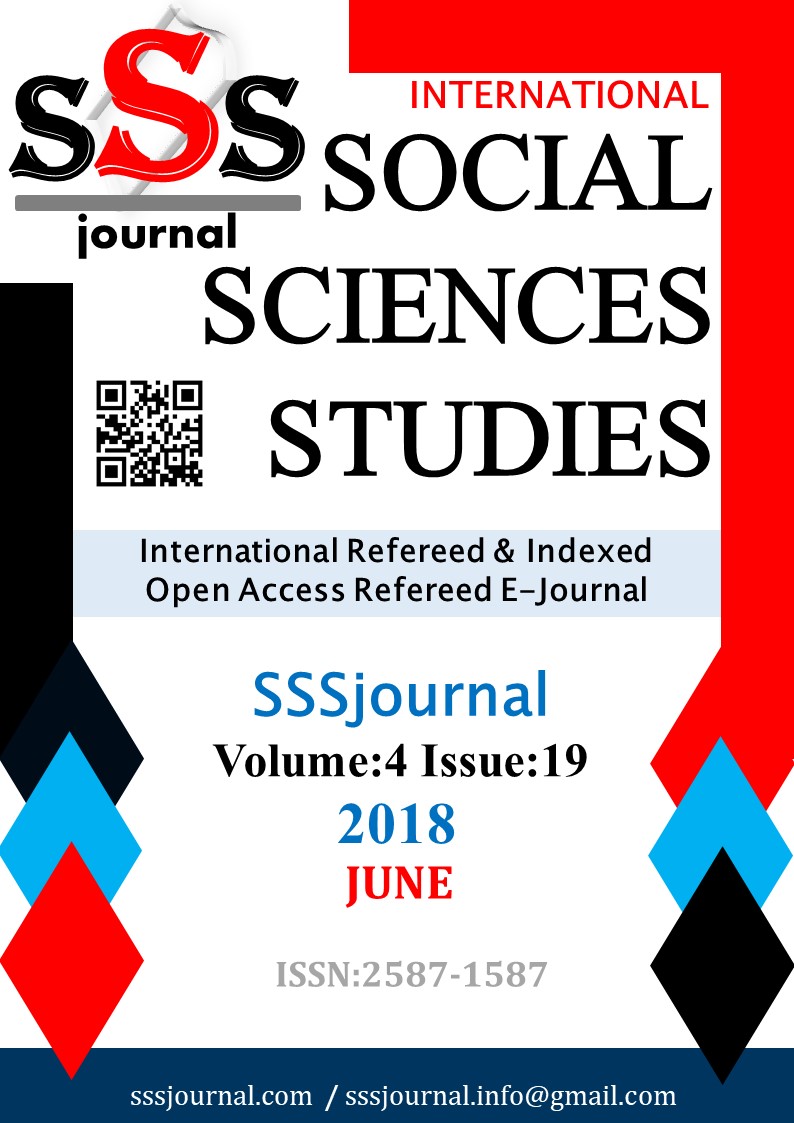Author :
Abstract
Bu çalışmada modern Türk edebiyatının en önemli yazarlarından biri olan Yusuf Atılgan’ın “Aylak Adam” adlı romanı yapılarına göre cümleler bakımından incelenmiştir. Çalışmanın amacı, söz dizimi çalışmalarına katkıda bulunmak ve bu eserden hareketle Yusuf Atılgan’ın dili nasıl kullandığını tespit edip üslubu ile ilgili birtakım bilgilere ulaşmaktır. Türkçenin zengin cümle kalıplarını “Aylak Adam” romanından alınan cümlelerle örneklendirmektir. Türk dilini büyük bir hassasiyetle eserlerine kullanan Yusuf Atılgan’ın adı geçen eserindeki cümle türleri konusunda herhangi bir çalışmanın yapılmamış olması bu konuda çalışmanın gerekliliğini göstermiştir. Romandan seçilen cümleler Türkiye Türkçesi dil bilgisi geleneksel yöntemiyle cümle türleri bakımından incelenmiş, cümleler fişleme yöntemiyle gruplandırılmıştır. Çalışmaya başlandığı zaman, yapılarına göre cümleler hakkında yazılmış olan eserler taranmış ve farklı dilcilerin bu konuya ilişkin görüşlerine yer verilmiştir. Yapılarına göre cümleler sınıflandırılırken romanda örneğine rastlanmayan ya da az rastlanan cümle türlerine de yer verilmiştir. Bu bölümde eserdeki yapılarına göre cümleler üzerine tespit edilerek gösterilmiş ve sayısı bakımından birleştikleri ve ayrıldıkları hususlar teker teker ele alınarak incelenmiştir. Cümle şekilleri mümkün olduğu kadar bol örnekle açıklanıp, bu cümle türüne en iyi, en doğru örneği teşkil eden cümlenin yer almasına çalışılmıştır. Burada cümle türü olan cümleler sayfa ve satır numaralarıyla gösterilmiştir. Çalışmanın son bölümü sonuç bölümüdür. Burada yapılarına göre cümlelerin sayısı belirlenmiş ve tablolarla gösterilmiş.
Keywords
Abstract
In this work, Yusuf Atılgan, one of the most important authors of modern Turkish literature, has been examined from the novel "The Loiterer" according to the constructions. Our aim is to contribute to the study of syntax and to find out how Yusuf Atılgan uses the language in this work and reach some information about the style. It is to exemplify the phrases of the Turkic rich sentences we have taken from our writing. The fact that Yusuf Atılgan, who uses the Turkish language to his works with great sensitivity, did not have any work on the sentence types mentioned in his last work has shown the necessity of studying this subject. Novel selected sentences from Turkey were examined in terms of sentence types with traditional methods of the Turkish gramercilig. Credits are grouped by the method of selection, by the method of selection. When we started to work, the works written on the cues were scanned according to the structures and the opinions of the different linguists on this topic were given. According to the structures, the sentence types that are not encountered or rare in the roman type are included in the categorization. In this section, they are identified and shown on the censuses according to the structures in the book, and they are examined one by one in terms of the number of them united and separated. Sentence patterns have been explained with as many examples as possible, and this sentence has been tried to include the best and the most correct example. The sentence type sentences are shown by page and line numbers. The last part of the work is the result part. Here, according to the structures, the number of cues is determined and shown on the tables.
Keywords
- Banguoğlu, T. (2007). Türkçenin Grameri, TDK Yayinlari, Ankara.
- Banguoğlu, T. (2007). Türkçenin Grameri, TDK Yayinlari, Ankara.Bilgegil, K. (1984). Türk Dilbilgisi, Dergah Yayınları, İstanbul.Dizdaroglu. H. (1976). Tümce Bilgisi, TDK. Yayınları, Ankara.Eker, S. (2006). Çağdaş Türk Dili, Grafiker Yayınları, Ankara.
- Ergin, M. (2009). Türk Dil Bilgisi, Bayrak Basım Yayım Tanıtım, İstanbul.
- Gece, M. (1998). Türkiye Türkçesinde Bağlı Cümle. Türk Dili Dergisi, Ekim, C: /II, S: 562, Ankara. Gencan, T.N. (1992). Dilbilgisi lise I-II-III, İstanbul, Kanaat Yayınları.
- Güneş, S. (1999).Türk Dili Bilgisi, D.E.Ü. Yayınları, İzmir.
- Gülensoy, T. (1992). Türkçe Dersleri, Erciyes Üniv. Yayınları, Kayseri.Hatıpoğlu, H. (1972). Türkçenin Sözdizimi, TDK. Yayınları, Ankara.
- Karahan, L., Ercilasun, A. B. (1994). Türk Dili, Deniz Yayınevi, İstanbul.
- Karahan, L. (2000). Yapı Bakımından Cümle Sınıflandırmaları Üzerine, Türk Dili, Sayı 583 (Temmuz), s.16-23.
- Karahan, L. (1999). Türkçede Söz Dizimi, Akçağ Yayınları, Ankara.
- Karahan, L. (1999) Türkçede Söz Dizimi-Cümle Tahlilleri, AkçağYay., AnkaraKarahan, L. (2005) Türkçede Söz Dizimi, Akçağ Yayınları, Ankara.
- Karahan, L. (1993). Türkçede Birleşik Cümle Problemi, Türk Gramerinin Sorunları Toplantısı, Türk Dil Kurumu, 22-23 Ekim 1993, Ankara
- Karaörs, M. M. (1993). Türkçenin Söz Dizimi ve Cümle Tahlilleri”, Erciyes Üniversitesi Yayınları, Kayseri.Karaörs, M. M. (2005). Türk Lehçelerinde Karsılastırmalı Sekil ve Cümle Bilgisi, Akçağ Yayınları, Kayseri. Korkmaz, Z. (2003). Türkiye Türkçesi Grameri (Sekil Bilgisi), TDK Yayınları, Ankara.
- Korkmaz, Z.; Ercilasun A.; Zülfikar, H.; Akalın M.; Gülensoy T.; Parlatır İ. & Birinci Necat,(1995). Türk Dili Ve Kompozisyon Bilgileri, Yükseköğretim Kurulu Matbaası, Ankara.
- Özkan, M & Sevinçli, V. (2009). Türkiye Türkçesi Söz Dizimi, Akademik Kitaplar, Çalış Ofset Matbaacılık, İstanbul.





